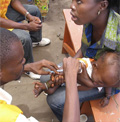 With an increased demand for the ‘pentavalent’ vaccine and a reduced price, the average price is set to fall.
With an increased demand for the ‘pentavalent’ vaccine and a reduced price, the average price is set to fall.
The story has made a big splash in the media this week and puts the spotlight firmly on immunisation for the world’s poorest people.
In fact, GAVI estimates that the latest decrease is part of a 30% reduction in price over the last seven years.
The vaccine protects children against diphtheria, tetanus, pertussis, Haemophilus influenzae type b (Hib), and hepatitis B, and is particularly useful in low-income countries. The improved affordability of such pentavalent vaccine is important because access to health services in rural and remote areas is often limited and parents have a much harder time bringing their infants to be regularly vaccinated.
New data shows that since GAVI’s inception in 2000, 288 million additional children have been immunised and over five million premature deaths prevented.
Efforts to map out a sustainable way to make essential vaccines affordable while ensuring investment in production and research have been under way for some time.
One novel approach which has gained ground in recent years is the concept of tiered pricing. This means that different classes of buyers (for instance different countries) are charged different prices for the same product. With vaccines, this effectively means low-income countries are charged a reduced price.
The aim is to reduce financial barriers to vaccine access for developing nations and emerging economies while allowing manufacturers with a profitable market in wealthier countries as an incentive to develop new products.
For more, check out this GAVI video on innovative financing for vaccines and the WHO’s briefing paper on tiered pricing for vaccines.




